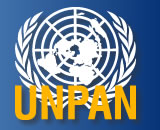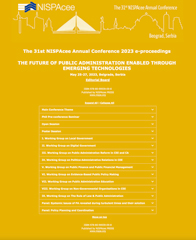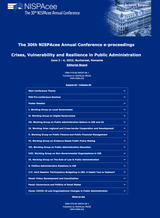III. Working Group on Strategic Leadership in Central Government
WG Programme Coordinators:Martin Brusis, Centre for Applied Policy Research, University of Munich, Germany
Email: martin.brusis@lrz.uni-muenchen.de
Radoslaw Zubek, London School of Economics and Political Science, UK
Email: r.zubek@lse.ac.uk
NISPAcee Project Manager:
Introduction
The working group on strategic leadership in central government was established in 2003 at the NISPAcee annual conference in Bucharest. The aim of the working group is to investigate the institutional underpinnings of strategic leadership in central government. From the start, its main focus has been on the core executive and its role in furthering strategic leadership in government. The working group met for the first time in May 2004 at the 12th NISPAcee conference in Vilnius. The participants discussed the development of strategic capacities at the centre of government and the impact of core executive institutions on policy-making. In 2004-2005 the working group will continue with its focus on the role of the core executive institutions in ensuring a strategic orientation. The immediate objective is to develop a joint publication on ‘Core Executive and Strategic Leadership’.
We now invite papers for the forthcoming 13th annual NISPAcee conference in Moscow. The papers should strictly follow the research guidelines presented below.
How we understand the problem
We conceive strategic leadership as a capacity of the central government to make and implement policy decisions that are integrative and welfare-maximizing; that are knowledge-based and consider dynamic policy externalities and interdependencies; and that are informed by a longer-term perspective going beyond immediate re-election concerns.
All governments face inherent problems in demonstrating capacity for strategic leadership. The problems derive from internal opportunity structures that encourage ministers and their staff to ‘go it alone’ or pursue narrow departmental interests at the expense of the strategic interests of the cabinet. Three types of such institutional incentives merit special attention.
- First, the political performance of individual ministers is judged based on the size of benefits that their policies bring to their department and social and economic clientele. For example, the health minister is closely monitored and stands to be visibly rewarded and punished by the medical community. This departmental bias may be further reinforced by the need to secure the support of the party organization and departmental staff.
- Second, ministerial decisions and behaviour reflect, and may be driven by, the political interaction among the parties of the governing coalition. If the number of parties in government is high, ideological distance between parties is large and internal cohesion of parties is low, ministers affiliated with such parties are inclined to use their portfolio in order to serve party interests at the expense of cabinet interests.
- Third, ministers and their staff have not only strong incentives but also the formal power to bring policies closer to their own departmental interests. Thanks to the principle of ministerial autonomy, ministers have exclusive agenda-setting powers within their policy jurisdictions. The agenda-setting powers enable ministers to decide whether and when to change the existing policies and to bring collective decision-making closer to their own preferences.
Governments have four principal types of resources that they use to affect the outside world. These are: finance, rules, organization and information. All such resources may be used by ministerial departments to pursue strategic government goals or to further their narrow departmental interests.
We invite papers that cover the strategic management of one or more of these resources:
-
strategic management of public finance – the focus here is on the strategic orientation in budgetary policy. The questions asked include: To what extent departmental budgetary allocations reflect the general priorities of the government? What is the proportion of the spending that is driven by strategic priorities as opposed to that driven by short-term particularistic concerns?
-
strategic management of rule-making – the focus is on the strategic orientation in the use of legislation by ministerial departments. The questions asked include: To what extent cabinet legislative plans reflect the general law-making priorities of the government as a whole? To what extent legislative plans are implemented in practice? How much legislation is proposed and adopted ad hoc by departments? How does the government ensure the support of its parliamentary majority for government-sponsored bills?
-
strategic management of organization – this theme centres on the strategic management of governmental organization. The questions asked include: To what extent the internal organization of the government reflects the strategic priorities of the government? How effective are mechanisms of inter-ministerial co-ordination? To what extent ministries/agencies are established ad hoc to further short-term particularistic interests? How are strategic cabinet interests represented in recruitment and personnel policies?
-
strategic management of information – the focus is on the management of informational messages that the government sends to the outside world. The questions asked include: To what extent ministers and departments follow the cabinet line in communications with the outside world? Do ministers speak against the cabinet? How does the cabinet manage its relations with the media?
The explanatory variable is the institutional arrangements at the centre of government. In organizational terms, the focus is on the prime minister’s offices, cabinet offices, finance ministries, specialized secretariats, cabinet committees, coalition management mechanisms, communication arrangements at the centre of government. Papers should study the type of incentives such core executive institutions provide vis-ŕ-vis individual ministers and their departmental staff. A typology of such institutional incentives should be developed to capture cross-sectoral, cross-temporal or cross-national variation. Descriptive accounts of organizational detail should be kept to a minimum.
The dependent variable is the strategic orientation in the management of resources. Variation in the dependent variable should be examined using performance indicators (both qualitative and quantitative) that will measure the extent to which government action is driven by strategic orientation. These may refer both to procedural and substantive aspects of policy making (e.g. reliability of government fiscal commitments, quality of legislative preparation process, etc).
Papers should adopt an explicit research methodology (qualitative or quantitative) and be guided by a rigorous analytical/theoretical approach. Papers without a theoretical framework may be rejected.




 Price:
Price: 








